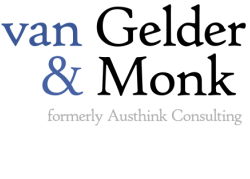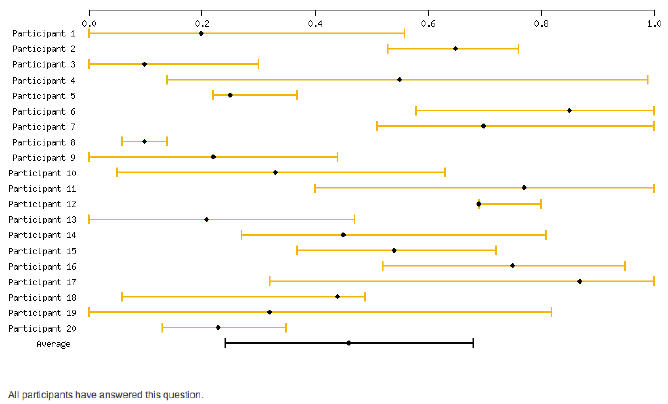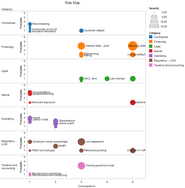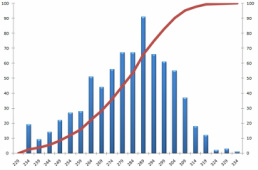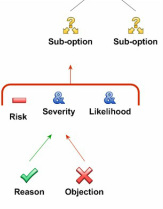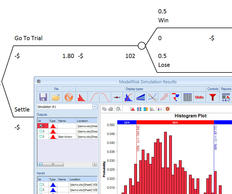Risk
Risks are any integral part of any significant decision. However in many organisations risks are, if not largely ignored, being handled using very simplistic methods. Often, risk analysis is done using "scoring" or "risk matrix" approaches, described by risk expert Douglas Hubbard as worse than useless.
van Gelder & Monk can help you bring greater clarity and rigour to your organisation's thinking about risks. We apply
We don't use a single, one-size-fits-all approach. Rather, working closely with you, we review the nature of risk in your domain, how risks are currently handled, and how your processes might be improved. We focus on the search for "low-hanging fruit" - changes which can make a big difference while costing little to implement.
van Gelder & Monk can help you bring greater clarity and rigour to your organisation's thinking about risks. We apply
- principles of cognitive science
- quantitative risk analysis techniques
- information visualisation, and
- our experience of risk management processes in a variety of organisations
We don't use a single, one-size-fits-all approach. Rather, working closely with you, we review the nature of risk in your domain, how risks are currently handled, and how your processes might be improved. We focus on the search for "low-hanging fruit" - changes which can make a big difference while costing little to implement.
|
Just how severe are your risks? Proper risk estimation is the crux of good risk management. Yet organisations often just crudely classify risks on a 1-5 scale. We can help you to make more rigorous, quantitative, collective estimates. In particular, we can run workshops using techniques based on the best current research to pool the wisdom of all your domain experts in order make the best collective estimates of the severity of risks.
|
A major decision can involve complex sets of risks. To properly judge the overall riskiness of a proposed action, you must survey the overall risk profile. This is almost impossible without taking advantage of the power of visualisation. We specialise in developing innovative visualisations tailored to the specific nature of your complex risk profiles. In short, we can help you see what you're really dealing with.
|
There are two kinds of risk analysis - informal, using tables, scoring, heat maps, etc., and formal, using quantification and Monte Carlo methods. Most organisations opt for the former, not realising how sloppy such informal methods usually are, and how straightforward it can be to take advantage of formal methods. We can help you down this path in two ways. We can assist you with the application of formal risk analysis to a particular decision, or we can help you introduce formal methods into your standard practices.
|
|
When large decisions are being made, there is typically much deliberation about the options, benefits and risks. A formal risk analysis might be ideal, but it may also be impractical for whatever reason. The challenge then is to improve the quality of group deliberation about risks. This can be done using an extension of our decision mapping methods to cover risks and benefits. We offer facilitation with such methods to assist with particular decisions, or training to embed the techniques into your organisation.
|
In large organisations the most significant decisions are made by boards or high-level committees. These decision makers rely heavily on information provided by teams who may have been working on the project for months. This information generally includes numerous risk estimates. It is vital that the decision makers properly understand the risk information. In our experience, standard risk communication practices are seriously deficient in this regard. We can work with you to introduce relatively simple changes which can dramatically improve the ease and accuracy with which high-level decision makers comprehend complex risk profiles.
|
Decisions to pursue litigation, or to settle, and for what amounts, are inherently risk-laden. Lawyers and their clients frequently make these decisions using intuitive ("gut") approaches, which yield comparatively little insight into the nature of the risks involved and the best strategies for dealing with them. We can assist in high-stakes litigation decisions by bringing to bear the best current methods for risk analysis, including decision trees, Monte Carlo simulation and real options analysis. Informed by such analysis, clients can more confidently make optimal decisions given their goals and risk tolerance.
|
Discuss with us...
To discuss any of these options, or more generally to explore how we can assist you to improve thinking about risk in your organisation, please contact
Tim van Gelder
[email protected]
Tim van Gelder
[email protected]
